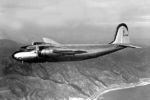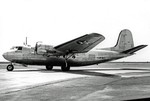R3D
| Country | United States |
| Manufacturer | Douglas Aircraft Company |
| Primary Role | Transport |
| Maiden Flight | 20 February 1939 |
Contributor: David Stubblebine
ww2dbaseThe twin-engine DC-5 was the only aircraft in the "Douglas Commercial" series designed at the El Segundo plant in California. With its high-wing and tricycle landing gear, the DC-5 was quite different from other airliners in the DC line. One prototype was built and it quickly showed the need for a slight design change to improve stability. The traditional flat horizontal stabilizers were adjusted with a 15-degree upward angle that created the Douglas signature look to the empennage seen later on the A-20 Havoc, A-26 Invader, and others.
ww2dbaseThe DC-5 prototype and four production DC-5s were built before World War II. The 16-seat airliner was intended for shorter routes, but by the time it entered service in 1940, the war was under way. William Boeing bought the prototype for his personal use and named it "Rover" but once war broke out, the Navy impressed it to replace one that was lost prior to delivery. The other four airplanes had been purchased by the Dutch airline KLM and flown in the Dutch East Indies. In 1942, these aircraft were used to evacuate civilians from Java to Australia. On Feb 9, 1942, one plane was damaged by Japanese strafing at Batavia (Jakarta) and left behind. The Japanese captured it, repaired it, and flew it to Japan for evaluation. The three other KLM planes flew in Australia throughout the war as military transports for the US Army Air Forces.
ww2dbaseBefore the war, the US Navy ordered seven DC-5s and designated them as the R3D; three R3D-1s flew with the Navy as 16-seat personnel carriers and four R3D-2s became 22-seat paratrooper versions with the US Marine Corps. Two of the Marine Corps planes were assigned to Marine Air Station Ewa in Hawaii in 1940. In Nov 1941, one of those was assigned to "Commander, Air, Battle Force, US Fleet" and assigned to Ford Island. The other was shot down by a Japanese submarine off the coast of Australia 55 days after the Pearl Harbor Attack.
ww2dbaseIt was not until March 1945 that the paperwork was finally completed to formalize the transfer of the three KLM airliners to the US Army Air Forces in Australia and only then did they receive their USAAF designations as C-110s.
ww2dbaseAfter the war, there was no interest in the mid-range DC-5 as an airliner because of the vast number of longer-range DC-3s available as military surplus so DC-5 production ended with a total of only 12 planes built.
ww2dbaseSources:
Wikipedia
Boeing
Jack McKillop
Geoff Goodall; Australian Aviation
Last Major Revision: Feb 2015
SPECIFICATIONS
R3D
| Machinery | 2 Wright GR-1820-F62 Cyclone Radial Engines |
| Crew | 3 |
| Span | 23.77 m |
| Length | 18.95 m |
| Speed, Cruising | 370 km/h |
| Range, Normal | 2,575 km |
Photographs
 |  |
Please consider supporting us on Patreon. Even $1 per month will go a long way! Thank you. Please help us spread the word: Stay updated with WW2DB: |
- » US Women's Army Corps "Six Triple Eight" Awarded with Congressional Gold Medal (30 Apr 2025)
- » Wreck of Soviet Submarine M-49 Found (10 Apr 2025)
- » Japanese Emperor Visited Iwoto (Iwo Jima) (8 Apr 2025)
- » Race, Holocaust, and African-American WW2 Histories Removed from the US Naval Academy Library (7 Apr 2025)
- » US Government Plans to Purge WW2 Information (17 Mar 2025)
- » See all news
- » 1,169 biographies
- » 337 events
- » 44,828 timeline entries
- » 1,244 ships
- » 350 aircraft models
- » 207 vehicle models
- » 376 weapon models
- » 123 historical documents
- » 261 facilities
- » 470 book reviews
- » 28,520 photos
- » 365 maps
Lt. Gen. Lewis B. "Chesty" Puller, at Guadalcanal